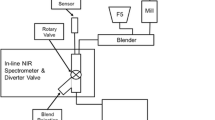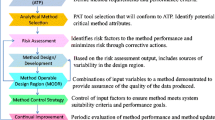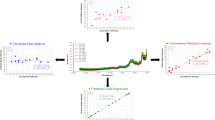Abstract
An online near-infrared (NIR) spectroscopy platform system for real-time powder blending monitoring and blend endpoint determination was tested for a phenytoin sodium formulation. The study utilized robust experimental design and multiple sensors to investigate multivariate data acquisition, model development, and model scale-up from lab to manufacturing. The impact of the selection of various blend endpoint algorithms on predicted blend endpoint (i.e., mixing time) was explored. Spectral data collected at two process scales using two NIR spectrometers was incorporated in a single (global) calibration model. Unique endpoints were obtained with different algorithms based on standard deviation, average, and distributions of concentration prediction for major components of the formulation. Control over phenytoin sodium’s distribution was considered critical due to its narrow therapeutic index nature. It was found that algorithms sensitive to deviation from target concentration offered the simplest interpretation and consistent trends. In contrast, algorithms sensitive to global homogeneity of active and excipients yielded the longest mixing time to achieve blending endpoint. However, they were potentially more sensitive to subtle uniformity variations. Qualitative algorithms using principal component analysis (PCA) of spectral data yielded the prediction of shortest mixing time for blending endpoint. The hybrid approach of combining NIR data from different scales presents several advantages. It enables simplifying the chemometrics model building process and reduces the cost of model building compared to the approach of using data solely from commercial scale. Success of such a hybrid approach depends on the spectroscopic variability captured at different scales and their relative contributions in the final NIR model.









Similar content being viewed by others
References
Institute NC. [Available from: https://www.cancer.gov/publications/dictionaries/cancer-terms/def/phenytoin-sodium. Accessed 09/11/2022.
FDA. FY 2015 Regulatory Science Research Report: Narrow Therapeutic Index Drugs. 2015. https://www.fda.gov/industry/generic-drug-user-fee-amendments/fy2015-regulatory-science-research-reportnarrow-therapeutic-index-drugs. Accessed 09/11/2022.
Levy G. What are narrow therapeutic index drugs? Clin Pharmacol Ther. 1998;63(5):501–5.
Muller PY, Milton MN. The determination and interpretation of the therapeutic index in drug development. Nat Rev Drug Discovery. 2012;11(10):751–61.
Greenberg RG, Melloni C, Wu H, Gonzalez D, Ku L, Hill KD, et al. Therapeutic index estimation of antiepileptic drugs: a systematic literature review approach. Clin Neuropharmacol. 2016;39(5):232–40.
National Archives, Code of Federal Regulations. 21 CFR Part 211.110. Sampling and testing of in-process materials and drug products. chrome extension://efaidnbmnnnibpcajpcglclefindmkaj/ https://www.govinfo.gov/content/pkg/CFR-2021-title21-vol4/pdf/CFR-2021-title21-vol4-sec211-110.pdf. Accessed on 09/11/2022.
CDER, CBER. Guidance for Industry Q8(R2) Pharmaceutical Development Silver Spring, Maryland: Food and Drug Administration (FDA) Center for Drug Evaluation and Research. In: Regulatory Information. FDA. 2009. https://www.fda.gov/regulatory-information/search-fda-guidance-documents/q8r2-pharmaceutical-development. Accessed 12 Sept 2022.
Chiang PC, Wong H. Incorporation of physiologically based pharmacokinetic modeling in the evaluation of solubility requirements for the salt selection process: a case study using phenytoin. AAPS J. 2013;15(4):1109–18.
Madhavi N, Sudhakar B, Ravikanth PV, Mohon K, Murthy KVRJJoB,. Bioavailability. Formulation Eval Phenytoin Sodium Sustained Release Matrix Tablet. 2013;4:1–6.
Gugler R, Manion CV, Azarnoff DL. Phenytoin: pharmacokinetics and bioavailability. Clin Pharmacol Ther. 1976;19(2):135–42.
Neuvonen PJ. Bioavailability of phenytoin: clinical pharmacokinetic and therapeutic implications. Clin Pharmacokinet. 1979;4(2):91–103.
Sekikawa H, Fujiwara J, Naganuma T, Nakano M, Arita T. Dissolution behaviors and gastrointestinal absorption of phenytoin in phenytoin-polyvinylpyrrolidone coprecipitate. Chem Pharm Bull. 1978;26(10):3033–9.
Barnes JN, Rascati KL. Switching of antiepileptic drug formulations. The journal of pediatric pharmacology and therapeutics : JPPT : the official journal of PPAG. 2010;15(2):64–5.
Borgheini G. The bioequivalence and therapeutic efficacy of generic versus brand-name psychoactive drugs. Clin Ther. 2003;25(6):1578–92.
Rosenbaum DH, Rowan AJ, Tuchman L, French JA. Comparative bioavailability of a generic phenytoin and dilantin. Epilepsia. 1994;35(3):656–60.
Hickey AJ, D. G. Pharmaceutical Process Engineering. Drugs and the pharmaceutical sciences, v. 195. 2nd ed: New York : Informa Healthcare; 2010. p. 155–6.
Xie L, Wu H, Shen M, Augsburger LL, Lyon RC, Khan MA, et al. Quality-by-design (QbD): effects of testing parameters and formulation variables on the segregation tendency of pharmaceutical powder measured by the ASTM D 6940–04 segregation tester. J Pharm Sci. 2008;97(10):4485–97.
Alexander A, Muzzio FJ, Shinbrot T. Segregation patterns in V-blenders. Chem Eng Sci. 2003;58(2):487–96.
Alexander A, Shinbrot T, Johnson B, Muzzio FJ. V-blender segregation patterns for free-flowing materials: effects of blender capacity and fill level. Int J Pharm. 2004;269(1):19–28.
Arratia PE, Duong N-H, Muzzio FJ, Godbole P, Lange A, Reynolds S. Characterizing mixing and lubrication in the Bohle Bin blender. Powder Technol. 2006;161(3):202–8.
Bridgwater J. Fundermental Powder Mixing Mechanisms. Powder Technol. 1976;15(2):215–36.
Lacey PMC. Developments in the theory of particle mixing. J Appl Chem. 1954;4(5):257–68.
Moakher M, Shinbrot T, Muzzio FJ. Experimentally validated computations of flow, mixing and segregation of non-cohesive grains in 3D tumbling blenders. Powder Technol. 2000;109(1–3):58–71.
Sudah OS, Coffin-Beach D, Muzzio FJ. Effects of blender rotational speed and discharge on the homogeneity of cohesive and free-flowing mixtures. Int J Pharm. 2002;247(1–2):57–68.
Williams JC. The mixing of dry powders. Powder Technol. 1968;2(1):13–20.
Yin T. A guide to blend uniformity. J GXP Compl. 2007;12(1):46–51.
Igne B, Juan Ad, Jaumot J, Lallemand J, Preys S, Drennen JK, et al. Modeling strategies for pharmaceutical blend monitoring and end-point determination by near-infrared spectroscopy. Int J Pharm. 2014;473(1):219–31.
Igne B, Talwar S, Drennen JK, Anderson CA. Online monitoring of pharmaceutical materials using multiple NIR sensors—part II: blend end-point determination. J Pharm Innov. 2013;8(1):45–55.
Lyon RC, Lester DS, Lewis EN, Lee E, Yu LX, Jefferson EH, et al. Near-infrared spectral imaging for quality assurance of pharmaceutical products: analysis of tablets to assess powder blend homogeneity. AAPS PharmSciTech. 2002;3(3):E17.
Wu H, White M, Khan M. An integrated process analytical technology (PAT) approach for process dynamics-related measurement error evaluation and process design space development of a pharmaceutical powder blending bed. Org Process Res Dev. 2015;19(1):215–26.
CDER, CVM, ORA. Guidance for Industry PAT — A Framework for Innovative Pharmaceutical Development, Manufacturing, and Quality Assurance. In: Regulatory Information. FDA. 2004. https://www.fda.gov/regulatoryinformation/search-fda-guidance-documents/pat-framework-innovative-pharmaceutical-development-manufacturing-and-quality-assurance. Accessed 12 Sept 2022.
Gouveia FF, Rahbek JP, Mortensen AR, Pedersen MT, Felizardo PM, Bro R, et al. Using PAT to accelerate the transition to continuous API manufacturing. Anal Bioanal Chem. 2017;409(3):821–32.
Hitzer P, Bäuerle T, Drieschner T, Ostertag E, Paulsen K, van Lishaut H, et al. Process analytical techniques for hot-melt extrusion and their application to amorphous solid dispersions. Anal Bioanal Chem. 2017;409(18):4321–33.
Laske S, Paudel A, Scheibelhofer O, Sacher S, Hoermann T, Khinast J, et al. A review of PAT strategies in secondary solid oral dosage manufacturing of small molecules. J Pharm Sci. 2017;106(3):667–712.
Porfire A, Filip C, Tomuta I. High-throughput NIR-chemometric methods for chemical and pharmaceutical characterization of sustained release tablets. J Pharm Biomed Anal. 2017;138:1–13.
Wu H, Tawakkul M, White M, Khan MA. Quality-by-design (QbD): an integrated multivariate approach for the component quantification in powder blends. Int J Pharm. 2009;372(1–2):39–48.
Biagi D, Nencioni P, Valleri M, Calamassi N, Mura P. Development of a near infrared spectroscopy method for the in-line quantitative bilastine drug determination during pharmaceutical powders blending. J Pharm Biomed Anal. 2021;204: 114277.
Blanco M, Gozález Bañó R, Bertran E. Monitoring powder blending in pharmaceutical processes by use of near infrared spectroscopy. Talanta. 2002;56(1):203–12.
Berman J, Elinski DE, Gonzales CR, Hofer JD, Jimenez PJ, Planchard JA, et al. Blend uniformity analysis: validation and in-process testing Technical Report No. 25 PDA PDA (Parenteral Drug association). PDA J Pharm Sci Technol. 1997;51(Suppl 3:i-iii):1–99.
Carstensen JT, Rhodes CT. Sampling in blending validation. Drug Dev Ind Pharm. 1993;19(20):2699–708.
Harwood C, Ripley T. Errors associated with the thief probe for bulk powder sampling. J Powder Bulk Solids Technol. 1977;11:20–9.
Muzzio FJ, Goodridge CL, Alexander A, Arratia P, Yang H, Sudah O, et al. Sampling and characterization of pharmaceutical powders and granular blends. Int J Pharm. 2003;250(1):51–64.
Danckwerts PV. Theory of mixtures and mixing. Chem Eng Res. 1953;6:355–61.
Wargo DJ, Drennen JK. Near-infrared spectroscopic characterization of pharmaceutical powder blends. J Pharm Biomed Anal. 1996;14(11):1415–23.
Wu H, Tawakkul M, White M, Khan MA. Quality-by-design (QbD): an integrated multivariate approach for the component quantification in powder blends. Int J Pharm. 2009;372(1):39–48.
Igne B, Zacour BM, Shi Z, Talwar S, Anderson CA, Drennen JK. Online monitoring of pharmaceutical materials using multiple NIR sensors—part I: blend homogeneity. J Pharm Innov. 2011;6(1):47–59.
Martínez-Cartagena PA, Sierra-Vega NO, Alvarado-Hernández BB, Méndez R, Romañach RJ. An innovative sampling interface for monitoring flowing pharmaceutical powder mixtures. J Pharm Biomed Anal. 2021;194: 113785.
El-Hagrasy AS, Morris HR, D’Amico F, Lodder RA, Drennen JK III. Near-infrared spectroscopy and imaging for the monitoring of powder blend homogeneity. J Pharm Sci. 2001;90(9):1298–307.
Ma H. Near-infrared chemical imaging as a tool for understanding blending of pharmaceutical materials and optimization of blending process control. Pittsburgh, PA: Duquesne University; 2008.
Hailey PA, Doherty P, Tapsell P, Oliver T, Aldridge PK. Automated system for the on-line monitoring of powder blending processes using near-infrared spectroscopy. Part I. System development and control. J Pharm Biomed Anal. 1996;14(5):551–9.
Sekulic SS, Wakeman J, Doherty P, Hailey PA. Automated system for the on-line monitoring of powder blending processes using near-infrared spectroscopy. Part II. Qualitative approaches to blend evaluation. J Pharm Biomed Anal. 1998;17(8):1285–309.
Sekulic SS, Ward HW, Brannegan DR, Stanley ED, Evans CL, Sciavolino ST, et al. On-line monitoring of powder blend homogeneity by near-infrared spectroscopy. Anal Chem. 1996;68(3):509–13.
De Maesschalck R, Sánchez FC, Massart DL, Doherty P, Hailey P. On-line monitoring of powder blending with near-infrared spectroscopy. Appl Spectrosc. 1998;52(5):725–31.
Puchert T, Holzhauer CV, Menezes JC, Lochmann D, Reich G. A new PAT/QbD approach for the determination of blend homogeneity: combination of on-line NIRS analysis with PC Scores Distance Analysis (PC-SDA). European journal of pharmaceutics and biopharmaceutics : official journal of Arbeitsgemeinschaft fur Pharmazeutische Verfahrenstechnik eV. 2011;78(1):173–82.
Berntsson O, Danielsson LG, Lagerholm B, Folestad S. Quantitative in-line monitoring of powder blending by near infrared reflection spectroscopy. Powder Technol. 2002;123(2):185–93.
Skibsted ETS, Boelens HFM, Westerhuis JA, Witte DT, Smilde AK. Simple assessment of homogeneity in pharmaceutical mixing processes using a near-infrared reflectance probe and control charts. J Pharm Biomed Anal. 2006;41(1):26–35.
Pedersen T, Rantanen J, Naelapää K, Skibsted E. Near infrared analysis of pharmaceutical powders with empirical target distribution optimization (ETDO). J Pharm Biomed Anal. 2020;181: 113059.
Merwe JVD, Steenekamp J, Steyn D, Hamman J. The role of functional excipients in solid oral dosage forms to overcome poor drug dissolution and bioavailability. Pharmaceutics. 2020;12:393. https://doi.org/10.3390/pharmaceutics12050393.
Andersen R, Brunoe TD, Nielsen K. Platform-based product development in the process industry: a systematic literature review. Int J Product Res. 2022. https://doi.org/10.1080/00207543.2022.2044085.
Muffatto M. Introducing a platform strategy in product development. Int J Prod Econ. 1999;60–61:145–53.
Alam MA, Liu YA, Dolph S, Pawliczek M, Peeters E, Palm A. Benchtop NIR method development for continuous manufacturing scale to enable efficient PAT application for solid oral dosage form. Int J Pharm. 2021;601: 120581.
Alvarado-Hernández BB, Scicolone JV, Ortega-Zuniga C, Román-Ospino AD, Colón-Lugo YM, Aymat E, et al. Method transfer of a near-infrared spectroscopic method for blend uniformity in a poorly flowing and hygroscopic blend. J Pharm Biomed Anal. 2020;180: 113054.
Osorio JG, Muzzio FJ. Evaluation of resonant acoustic mixing performance. Powder Technol. 2015;278:46–56.
Velez NL, Drennen JK, Anderson CA. Challenges, opportunities and recent advances in near infrared spectroscopy applications for monitoring blend uniformity in the continuous manufacturing of solid oral dosage forms. Int J Pharm. 2022;615: 121462.
Román-Ospino AD, Singh R, Ierapetritou M, Ramachandran R, Méndez R, Ortega-Zuñiga C, et al. Near infrared spectroscopic calibration models for real time monitoring of powder density. Int J Pharm. 2016;512(1):61–74.
Talwar S, Roopwani R, Anderson CA, Buckner IS, Drennen JK. Determination of spatially resolved tablet density and hardness using near-infrared chemical imaging (NIR-CI). Appl Spectrosc. 2017;71(8):1906–14.
Talwar S, Igne B, Anderson CA, Drennen JK. Evaluation of the effect of near infrared spectrometer wavelength range and calibration algorithms on prediction of crushing strength of pharmaceutical tablets. J Near Infrared Spectrosc. 2016;24(5):413–24.
Talwar S, Nunes C, Stevens T, Nesarikar V, Timmins P, Anderson CA, et al. Understanding the impact of chemical variability and calibration algorithms on prediction of solid fraction of roller compacted ribbons using near-infrared (NIR) spectroscopy. Appl Spectrosc. 2017;71(6):1209–21.
Shi Z, Cogdill RP, Short SM, Anderson CA. Process characterization of powder blending by near-infrared spectroscopy: Blend end-points and beyond. J Pharm Biomed Anal. 2008;47(4):738–45.
Mohan S, Momose W, Katz JM, Hossain MN, Velez N, Drennen JK, et al. A robust quantitative near infrared modeling approach for blend monitoring. J Pharm Biomed Anal. 2018;148:51–7.
El-Hagrasy AS, Drennen JK 3rd. A Process Analytical Technology approach to near-infrared process control of pharmaceutical powder blending. Part III: quantitative near-infrared calibration for prediction of blend homogeneity and characterization of powder mixing kinetics. J Pharm Sci. 2006;95(2):422–34.
Wu H, Khan M. Quality-by-Design (QbD): Process Trajectory Development for a Pharmaceutical Co-Precipitation Process Based On An Integrated Real-Time Process Monitoring Strategy. In: Reklaitis VR, Seymour CB, García-Munoz S, editors. Comprehensive Quality by Design for Pharmaceutical Product Development and Manufacture. New York: Wiley & Sons, Inc; 2017. p. 235–56.
FDA. 2012. https://www.fda.gov/regulatory-information/search-fda-guidance-documents/q8-q9-q10-questions-and-answersappendix-qas-training-sessions-q8-q9-q10-points-consider. Accessed 12 Sept 2022.
CDER. Development and Submission of Near Infrared Analytical Procedures. In: Regulatory Information. FDA. 2021. https://www.fda.gov/regulatory-information/search-fda-guidance-documents/development-and-submission-nearinfrared-analytical-procedures. Accessed 12 Sept 2022.
ASTM E2891-20. Standard Guide for Multivariate Data Analysis in Pharmaceutical Development And Manufacturing Applications (last updated Jul 08, 2020). In: ASTM Website. ASTM International. https://www.astm.org/e2891-20.html. Accessed 12 Sept 2022.
ASTM E2629-20. Standard Guide for Verification of Process Analytical Technology (PAT) Enabled Control Systems (last updated Aug 06, 2020). In: ASTM Website. ASTM International. https://www.astm.org/e2629-20.html. Accessed 12 Sept 2022.
Acknowledgements
Huiquan Wu would like to acknowledge the management support for the project, including but is not limited to, Drs. Rapti Madurawe, Mansoor Khan (currently at Texas A&M Health Science Center), and Vincent Vilker (retired).
Funding
This work was funded by FDA Grants including FDA CDER OPS OTR PAT-12 grant; FDA CDER Regulatory Science and Review (RSR) grants 04–16, 12–42, and 13–32; and FDA CDER OC OMQ grant.
Author information
Authors and Affiliations
Contributions
Sameer Talwar—substantial contributions to the conception or design of the work; or the acquisition, analysis, or interpretation of data for the work. Resposible for darfting the manuscript. Pallavi Pawar—substantial contributions to the conception, acquisition, analysis, or interpretation of data for the work. Huiquan Wu—agreement to be accountable for all aspects of the work in ensuring that questions related to the accuracy or integrity of any part of the work are appropriately investigated and resolved; revising it critically and final approval of the version to be published. Benoît Igne—drafting the work or revising it critically for important intellectual content. Koushik Sowrirajan—substantial contributions to the acquisition, analysis, or interpretation of data for the work. Suyang Wu—substantial contributions to the acquisition, analysis, or interpretation of data for the work. Richard Friedman—drafting the work or revising it critically for important intellectual content. Fernando J. Muzzio—final approval of the version to be published. James K. Drennen, III—final approval of the version to be published.
Corresponding authors
Ethics declarations
Conflict of Interest
The authors declare no competing interests.
Additional information
Communicated by Anurag S. Rathore.
Publisher's Note
Springer Nature remains neutral with regard to jurisdictional claims in published maps and institutional affiliations.
Rights and permissions
About this article
Cite this article
Talwar, S., Pawar, P., Wu, H. et al. NIR Spectroscopy as an Online PAT Tool for a Narrow Therapeutic Index Drug: Toward a Platform Approach Across Lab and Pilot Scales for Development of a Powder Blending Monitoring Method and Endpoint Determination. AAPS J 24, 103 (2022). https://doi.org/10.1208/s12248-022-00748-4
Received:
Accepted:
Published:
DOI: https://doi.org/10.1208/s12248-022-00748-4




